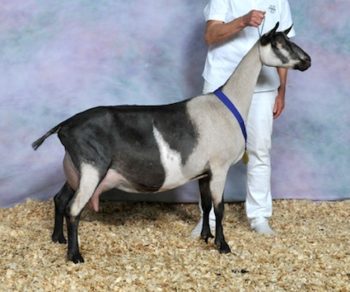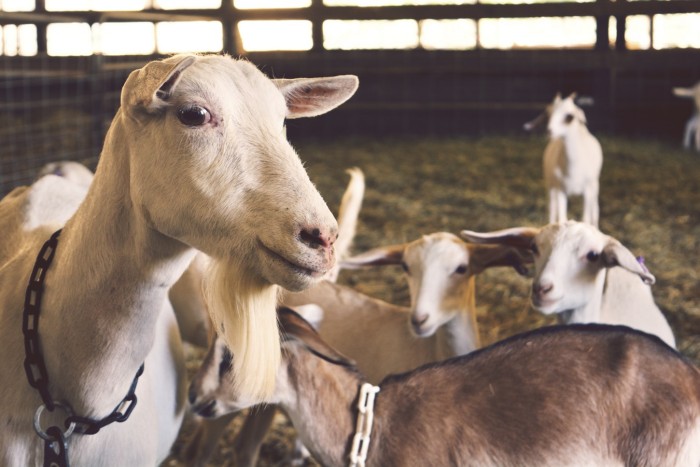There is a category substances that is called “generally regarded as safe.”[gras] Goat milk is not on this list. 200 million years of success in feeding does not produce a “gras” status!
Disgust is one of the six basic emotions.[17] It is a teaching emotion. When a mother finds her child putting some non food object in their mouths, she will say yuck and stick out her tongue and express distaste. The child learns what not to eat. My dog knows this. She doesn’t share my opinion all the time. A person in authority will direct people in the right direction. Using science as an unbiased arbiter of truth, doctors use this emotion to direct behavior. Health Canada uses disgust to sway opinion. Goat milk is yuck.
Translating terms into Greek attempts to make them sound more official.[18]
How many emotion laden yuck words are found in the conclusion of the “fresh Goat milk” article? Eleven, all false.
The use of disgust is used frequently in news broadcasts. A news man uttered, “If it bleeds, it leads”. One of reasons that a government lost an election was the “rancid tuna affair” of 1985. Rancid it a very strong yuck word. The food establishment inspectors of this plant declared that a large quantity of canned tuna was rancid. Rancidity is the breakdown of fats into shorter chained fats and aromatic oils. The tuna was safe to eat, but smelled. The company was getting tuna from around the world. The company went to the federal fisheries minister and asked them to allow the sale of the tuna. He said it was ok to sell. It became big news because of the word rancid. Words like rancid can turn peoples stomach as well as political affiliation. The minister reversed his position. The governing party lost the next election. I feel that this has influenced Canadian politics. It can change a person’s political point of view.
Score
Many infants are fed unmodified goat milk. How many is many? It’s more than a few. Let’s say a score of negative 50 .
Using a boy with CHARGE is another negative score. Negative 10.
Disregarding the four day history of diarrhea, when presented with a dehydration is another negative score Negative 10.
PEDIATRICS Journal publishing this article. Negative 100
Use of disgust to persuade. Negative 100
Total negative 270
Goats’ milk quackery [23]
This is the title of an article that was published in a prominent pediatrics journal. It presents the story of an 11 month old infant that suffered from anemia, folic acid and/or vitamin B12 deficiency. The child was breastfed until the mother developed mastitis at two weeks. This was followed by one week of infant formula. Then 10 months of goat milk “formula”. This is a frequent theme in the goat milk history. Most infant consumers of goat milk were infant formula failures. The child was developing normally until the anemia. The child was fed a mixture goat milk and corn syrup diluted with barley water for 10 months.
Home-made formulas made from canned, evaporated, whole milk (cow or goat) are not recommended as a breastmilk substitute. They are nutritionally incomplete (Briend, 2006; WHO, 2009). These formulas should only be considered for emergency, short-term use. They must be prepared safely, following directions from WHO’s Infant Feeding in Emergencies (WHO, 2007).[24]
The iron levels in the child’s blood were within normal limits. A UN formula for goat milk suggests; 40 mls goat milk, 20 mls water and 4 gms sugar.[24] This dilutes goat milk by 1/3 and lowers the amount of iron and folic acid by 1/3. The other nutrients would be reduced by 1/3 except for sugar.
This dilution is an attempt to resolve a ‘surplus of solutes’ problem, perceived to be found in goat milk. Kidneys can handle higher levels of solutes. People can live with one kidney. A problem is a problem only if it’s a problem. Goat milk and breastmilk have similar water to energy ratios. This study [25] states that normally it’s not a problem, and that human kidneys can easily deal with the solutes of cow milk. Cow milk and goat milk are similar in this area. The authors of this work are experts in this area. This article [26] mentions large differences in solute levels of blood. When food is consumed, when high activity levels happen or during environmental strains, the levels of solutes rises or falls. Kidneys straighten out these fluctuations easily. The kidneys that are grown by goat milk, are superior to the kidneys that are grown by infant formulas. Goat milk poses no problems for goat milk grown kidneys.
The child grew normally from 3 weeks of age to 11 months of age fed this formula. When a dilution occurs, it may take time for nutrient shortages to show up. It is a testament to goat milk success in infant feeding that no other shortages appeared in this infant over the 10 months of feeding. If the child was fed undiluted goat milk these shortages would not have shown up. This child is the science that put megaloblastic anemia on the authors list.[2] Since this science is not correct, megaloblastic anemia should be removed from the list.
This article is regarded as science. It is not a double blind study with a significant number of subjects in the study. This is a case study. If every case study of infant formula failure were to be published, there would be an encylopedia in every months issue.
The use of the word “quackery” indicates a bias. One of the flaws of quackery is bad science. Who’s the quack?
Score negative one for the successful feeding of the infant.
Score negative one for the use of the word quackery.
Score negative one for the failure of the infant formula.
Total negative 273
Case 2: You look like you’ve seen a goat[ 28 ]
The title of this article is informative. It says, “I have a bias”. Attitude? Humor? Goat – Ghost? How does one look like when they have seen a goat? Many people must have been seen looking at a goat, in a special circumstance. Perhaps in the future when all non-breastfed infants are fed goat milk, special looks would happen, involving infants that were fed goat milk. Parents would have a look too, a look of deep gratitude.
This infant went from breastfed to formula then to goat milk. The infant was fed formula for 4 or 5 days. Why the next switch? 4 or 5 days of screaming will drive mothers to examine alternatives. The infant was successfully fed with goat milk for 4 months and then anemia. Tests indicated low levels of hemoglobin. Examination also revealed an enlarged spleen. An infected spleen can reduce numbers of red blood cells and cause anemia.[29] This is not mentioned in the “seen a goat article”. In the conclusion of the article, it states that the spleen had shrunk some. Perhaps the infant got a course of antibiotics along with the rest of her treatments, which cleaned up her infection.
The above study [seen a goat] states infant anemia is to some degree, a common occurrence. Anemia is rare in breastfed infants younger than four months.[30]Lots of anemia without goat milk. There are 400 different kinds of anemia. It seems that iron is vastly complicated and difficult issue in the human body, with many “chains”. Its very important because it carries oxygen to the body.
- Score Negative 1
- Total negative 274
- false death – 100
- some doctors – 50
- less processing – 10
- conflict of interest -200
- exaggeration – 100
- Total -734





